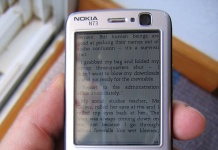 Scan today’s news and you’ll undoubtedly see plenty of stories about how the majority of content is being consumed on mobile devices. In fact, you’ll probably use your own mobile device when you do that scan.
Scan today’s news and you’ll undoubtedly see plenty of stories about how the majority of content is being consumed on mobile devices. In fact, you’ll probably use your own mobile device when you do that scan.
Like many of you, I read all my books on a tablet and most of my short-form content on my iPad Mini or my Android phone. Even though I spend several hours in front of a computer every day, the majority of that time is spent using productivity tools like PowerPoint, Excel and Outlook. I’ll read the occasional web page on my Mac but my phone and tablet are my go-to devices for business and casual reading.
The pundits say that publishers and content distributors need to think about smaller screens and shorter pieces of content. They’ll go on to tell you that responsive design is a must and it’s critical to granulize content so it can be read in smaller slices of time.
The oft-used scenario is someone standing in line at the grocery store. They’re bored and looking for something to do. Their phone is always with them, so how can you take advantage of that opportunity and cater to their need?
I think we’re missing a huge opportunity by simply saying existing content needs to be restructured and apps need to optimize every square inch of screen. Publishers should be thinking more about companion content for mobile, not just reformatting what they’ve already produced.
Here’s an example: I finally got around to reading David McCullough’s wonderful book about Harry Truman. Each night I read a few more pages before I go to bed. There’s no way I’d ever consider opening that ebook on my phone and trying to read it in line at the grocery store. In order to really engage I need at least 20-30 minutes of book reading time, not two or three minutes in a checkout line.
So although I’ll never read Truman at the store, I’d be thrilled to spend that time in an app that provides tidbits about Truman. Let’s take that a step further and suggest the app should offer more than random facts or stories about him; rather, it should use information about what I’ve read so far and it tailor today’s suggestions accordingly.
This app will know that I’m currently reading about the 1948 presidential election, so it gives me links and summaries of all the activities from that fall. The app also knows what today’s date is, so it’s able to provide noteworthy info from “this date in history” (e.g., September 14) as it relates to Truman’s life.
In short, the companion mobile app leads me to deeper engagement with the book I’m reading each night. Having access to something like this would only make me more excited to read the next installment of the book.
Don’t overlook the marketing opportunity this represents. Give the app away for free and promote other related titles inside it. That means tossing in samples of other related books. You might want to include other types of advertising in it as well. I don’t care how you monetize it; just make sure it truly serves as a valuable companion to the book I’m reading.
The UI for this could follow the same metaphor the Google mobile app uses. Simply tap the cards you want to want to open and swipe to discard the ones you’re not interested in. The app learns what you like and adjusts future recommendation cards accordingly (e.g., maybe you prefer more YouTube videos and less long-form articles).
Although a mobile strategy certainly needs to consider the screen size and a consumer’s on-the-go reading habits, sometimes the content’s original format shouldn’t be altered. Instead, think about the deeper engagement opportunities a companion mobile product could offer.
Reproduced with permission from Joe Wikert’s Digital Content Strategies.

































That’s a quite interesting idea, one I’ll have to ponder. It would be handy for a lot of writing. Often when someone writes a book on a topic or person, they end up with a lot of snippets that fit nowhere in the flow of the book. Those could be put in a separate, ‘on the go’ companion volume, i.e. _Truman on the Go_ or whatever. And since it is simply a bin into which unneeded snippets are tossed, it could be marketed for free to create interest in the longer paid volume.
I have adapted my writing for more limited attention spans. In my hospital series for nurses, patients and (soon) physicians, I try to focus each chapter on a single theme and keep it under 2,000 words, or about 5-10 minutes of reading. That’s not quite suitable for reading while waiting in line, but it does work for coffee breaks. You can see how that works here:
https://indd.adobe.com/view/c1892142-ecf8-4621-a7a9-eee8f0ce19ab
Click on the small arrow on the right to page through the book. That books is for nurses not for making me money, so you can find it for free here:
https://itunes.apple.com/us/book/senior-nurse-mentor/id1005818421
Amazon would not let me price it free and is pig-headedly refusing to match that free price. Someone Kindle-bound needs to complain “but I can get it free from Apple.”
——-
Years ago it did come to me, when I still watched TV, that it’d be nice to have a channel with little one-minute or thirty-second long snips of useful life information. When a commercial comes up, people could switch there, with the commercial running away in a little window. When the commercial was over, they could switch back. Advertisers would hate that, but I would love it. I might even start watching TV again.
No, probably nothing that radical.
–Michael W. Perry